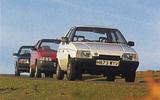Europe was changing. We'd experienced the revolutionary Autumn of Nations in 1989, which began in Poland and soon spread like wildfire behind the Iron Curtain.
By the end of that year, democracy had returned to Czechoslovakia. Just a year later, the very linchpin of communism, the Soviet Union, fell apart. And Yugoslavia was soon to follow, violently disintegrating into several Balkan states from 1992.
And so, unbeknownst to Autocar's testers, our November 1990 test of the three superminis representing these countries (or 'cheaps from the old Bloc', as we put it) was, in a way, the last hurrah for commie cars — loved and maligned as they had been by the British public for the previous decades.
Those three cars were the Skoda Favorit 136LX (£5446), the Lada Samara 1300SL (£5549) and the Yugo Sana 1.4 (£5495). Each was front-engined and front-wheel drive and the result of their overseers' swallowing of national pride. Italians and Germans had helped Skoda; Brits had done work for Lada; and Italians had assisted Yugo.

Which was the best bet?
"None of these cars will be bought for its performance," we said, "but all will provide adequate mobility for the family and none can be considered underpowered.
"As expected, the Yugo, with a Fiat Tipo 70bhp 1.4-litre engine, has the legs on the others. It will buzz and thrash its way to 97mph, passing 60mph in 13.2sec and managing 30-70mph in 14.1sec. Quite why the engine feels and sounds so gruff in this installation is a mystery.
"The Lada isn't far behind. The Soviet's 65bhp 1.3-litre iron/alloy engine, with siamesed valves in a non-crossflow cylinder head, doesn't savour revving. Only the cloth-eared will extract all of the available performance. It runs out of puff at 93mph, reaches 60mph in 13.4sec and records a 30-70mph time of 15.6sec.































Join the debate
Add your comment
I drive 2 of these
Had both the Lada and Skoda. Skoda was streets ahead, I had 2 of them. The interior was disposable but the later ones with VW input were much better finished. Loved the Favorit, and the Felicia that followed.
The Lada wasn't actually too bad. I think build quality improved and my paintwork was a nicely applied metallic green. And it drive surprisingly well, handled quite tidily and was quite "modern" to drive. Ride was a bit firm though. Nothing went wrong with it except the wiper motor.
But my favourite eastern clock cheapy was...the FSO Polonez! It lumbered along with big roomy cabin and comfortable seats, a nice gearchange and excellent all round disk brakes.
Build quality was aspirational, and it rusted to nothing after 5 years. But I'd have another one today.
Memories
This would have been 96/97 as I passed my test aged 17 in 96. The car had been my granddad's who had passed away.
As someone mentioned above, some people wanted the cheapest possible new car and my grandad apparently got a good deal on the car at the dealers, possibly due to the yellow colour!
I remember bits of the car falling off all over the place. It was ultimately scrapped and can't have made it to ten years old. Still have fond memories though, don't we all of our first cars!
I drive an Octavia now... :)
Rubbish test.
missing a time warp and a “vs Rolls Royce Cullinan” bit. Surely the same period of crap design. Warrants comparison. C’mon autocar, when are you going to deliver relevant tests?